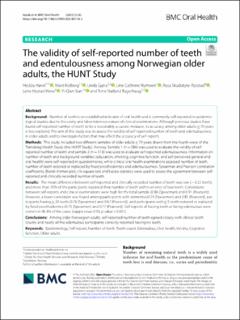| dc.description.abstract | Background Number of teeth is an established indicator of oral health and is commonly self-reported in epidemiological studies due to the costly and labor-intensive nature of clinical examinations. Although previous studies have found self-reported number of teeth to be a reasonably accurate measure, its accuracy among older adults ≥ 70 years is less explored. The aim of this study was to assess the validity of self-reported number of teeth and edentulousness in older adults and to investigate factors that may affect the accuracy of self-reports. Methods This study included two different samples of older adults ≥ 70 years drawn from the fourth wave of the Trøndelag Health Study (the HUNT Study), Norway. Sample 1 (n = 586) was used to evaluate the validity of self-reported number of teeth and sample 2 (n = 518) was used to evaluate self-reported edentulousness. Information on number of teeth and background variables (education, smoking, cognitive function, and self-perceived general and oral health) were self-reported in questionnaires, while clinical oral health examinations assessed number of teeth, number of teeth restored or replaced by fixed prosthodontics and edentulousness. Spearman and Pearson correlation coefficients, Bland–Altman plot, chi-square test and kappa statistics were used to assess the agreement between self-reported and clinically recorded number of teeth. Results The mean difference between self-reported and clinically recorded number of teeth was low (− 0.22 teeth), and more than 70% of the participants reported their number of teeth within an error of two teeth. Correlations between self-reports and clinical examinations were high for the total sample (0.86 (Spearman) and 0.91 (Pearson)). However, a lower correlation was found among participants with dementia (0.74 (Spearman) and 0.85 (Pearson)), participants having ≥ 20 teeth (0.76 (Spearman) and 0.67 (Pearson)), and participants with ≥ 5 teeth restored or replaced by fixed prosthodontics (0.75 (Spearman) and 0.77 (Pearson)). Self-reports of having teeth or being edentulous were correct in 96.3% of the cases (kappa value 0.93, p value < 0.001). | en_US |

